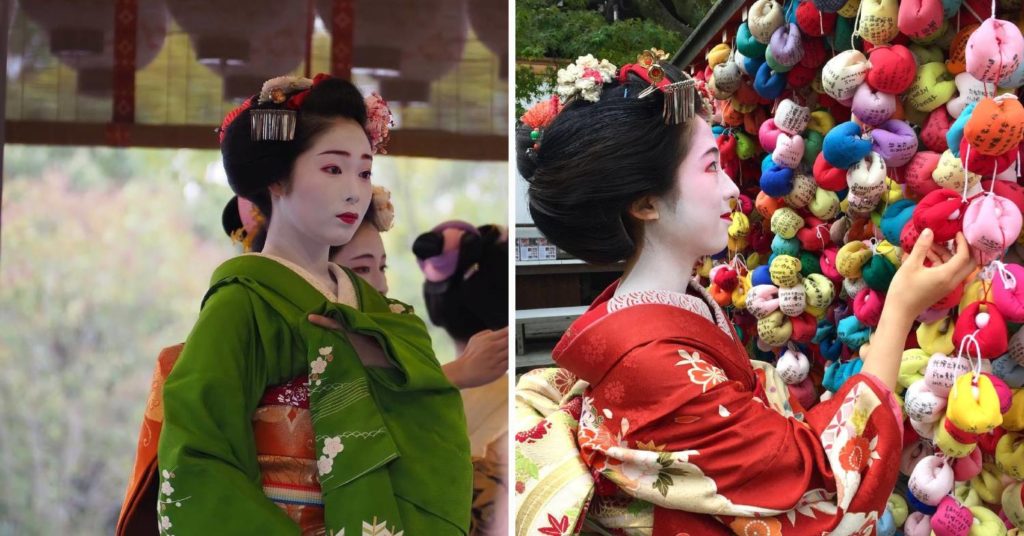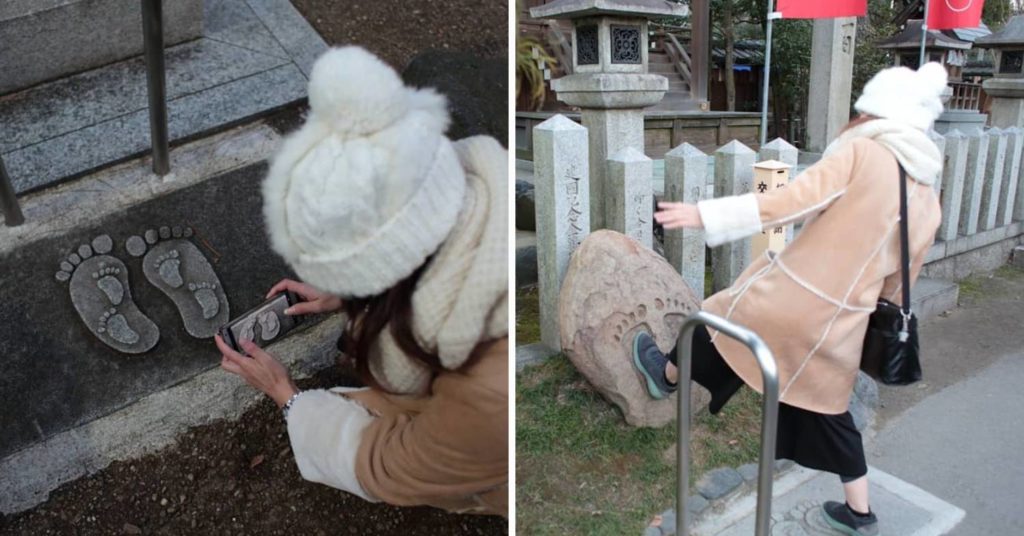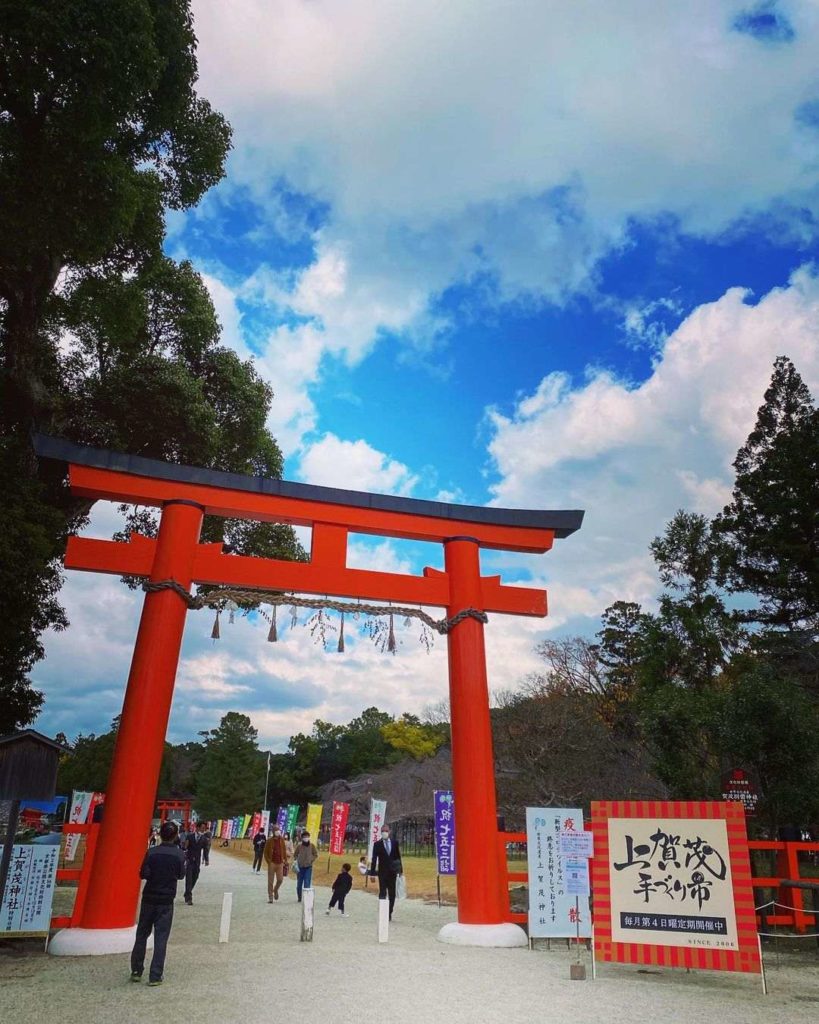Kyoto shrines to bless your studies, love life & more
Kyoto is a city steeped in tradition and culture. It is home to about 400 shrines, each one known for helping in different aspects of life, such as studies and love. A trip to the historical heart of Japan will not be complete without visiting one of these famous Kyoto shrines.
We’ve chosen 8 Kyoto shrines popular with both locals and tourists for their divine blessings for you to check out when you visit the city.
1. Kitano-Tenmangu – Studies

Image credit: @ishiichan0222
Kitano-Tenmangu is a famous shrine dedicated to Tenjin, a god known for blessing those in education. The shrine was built in 947 AD and Tenjin made his mark in Japanese history as the first deified human to have a shrine in his name.

Image credit: @japan_of_art
Besides Kitano-Tenmangu, there are hundreds of other shrines built in Tenjin’s name in order to appease his rage after his wrongful death.
Before being enshrined as a deity, Tenjin was known as Sugawara no Michizane, a well-known and intelligent scholar and politician. He later died in exile due to false accusations, and disasters began to strike Kyoto.
Today, these shrines are patronised by thousands of visitors, usually students, seeking divine blessings in their studies because Sugawara was one of the most intelligent scholars back in the day.

Image credit: Japanexperterna.se
It comes as no surprise that whenever the exam period nears, Kitano-Tenmangu would be overflowing with students who pray for good grades. It’s often packed with youths during the school trip season too.

Image credit: @japan_of_art
You will find many ox statues at Kitano-Tenmangu as they are considered to be Tenjin’s sacred spirit messengers. He has always had an interesting affinity with the ox – Tenjin was born in the Year and on the Day of the Ox, and an ox had carried his remains for burial.
As such, people believe that by rubbing the head of the ox statues found at Kitano-Tenmangu, you will be blessed with good luck and success in your studies.

Image credit: @taka23_48ta
Kitano-Tenmangu is gorgeous all year round, but we recommend visiting the popular shrine during the autumn to catch a beautiful mix of green, orange, red, and pink foliage surrounding the shrine.
Address: Kamigyo Ward, Bakurocho, 602-8386 Kyoto
Opening hours: 5.30AM-5.30PM, Daily (Oct – Mar) | 5AM-6PM, Daily (Apr – Sep)
Admission: Free
Directions: Take Kyoto City Bus 50, 101, or 111 from JR Kyoto Station and alight at Kitano Tenmangu-mae. It is a 30-minute bus ride.
Telephone: 075-461-0005
Website
2. Yasaka Shrine – Health & beauty

Image credit: @unbretonauxconfinsdumonde
Yasaka Shrine, or Gion Shrine, was built in 656 AD. One of the most frequently visited shrines in Kyoto, it garners thousands of local and foreign visitors each year. The popular Gion Festival has also been held here every July, since 970 AD.

Image credit: John Gillespie
The Gion Festival began as a result of a plague that hit Kyoto in 869 AD. A parade, much like the ones seen during the annual festival, was held to appease the plague deity, Gozu-Tenno, as the people believed that the epidemic happened because of his displeasure.
Since then, the parade has become a tradition that people have continued to observe for generations.

Image credit: @unbretonauxconfinsdumonde
There are several smaller shrines found within the grounds of Yasaka Shrine. One example is the Eki-jinja – “plague shrine” – believed to bless people with protection against diseases or with full recovery from illnesses.
Somin Shorai, who is enshrined at Eki-jinja, is known as the one sent by Gozu-Tenno to help stop the plague in Kyoto. After this incident, many Medicine Buddha statues were enshrined at Eki-jinja alongside Somin Shorai.

Image credit: @umirin527
Susanoo-no-Mikoto, a Shinto deity believed to protect the people against epidemic outbreaks, is also worshipped at Yasaka Shrine.

Image credit: Kumon
Henceforth, Yasaka Shrine became known for its health-related miracles. Thousands of people visit the shrine yearly to pray for good health or for illnesses to be cured.

Image adapted from: @ringo___323, @nana.h0506
Besides health, Yasaka Shrine is also known to be the go-to shrine for those seeking a blessing in the beauty department. 3 goddesses with astounding beauty are said to be enshrined at a secondary shrine called Utsukushi Gozen-sha. People visit this shrine to pray for internal and external beauty.

Image credit: @___tomo.s2_
If you wish to become pretty inside and out, head to the shrine and dab your face with the water at Utsukushi Gozen-sha. The special water is said to help purify your heart and body, thereby making you beautiful. You can also pray to the goddesses and write your prayer for beauty on wish tablets there.
Address: 625 Higashiyama Ward, Gionmachi Kitagawa, 605-0073 Kyoto
Opening hours: 24 hours, Daily
Admission: Free
Directions: 3-minute walk from Maruyama Park.
Telephone: 075-561-6155
Website
3. Jishu Shrine – Love

Image credit: @theshootingcomet
Located within the famous Kiyomizu-dera, Jishu Shrine is commonly visited by both singles and couples due to its love and matchmaking powers. Okuninushi-no-Mikoto, the deity enshrined at Jishu Shrine, has helped countless people find their Mr. and Mrs. Right.
The shrine of love is particularly famous for its Koi uranai-no-ishi – “love fortune-telling stones”.

Image credit: @iireland
Those looking to find love will often be found trying to walk with their eyes closed, from one love stone to the other, spaced about 10m apart. It is believed that you will find your one true love if you can successfully walk from one stone to the other. However, the sheer number of visitors makes this challenge even harder.

Image credit: @wannchauu
As such, most people would ask a friend or family member to give them directions. But this also means you will only find your Mr. or Mrs. Right with the assistance of others.
Those who manage to find their soulmate and settle down will usually make a trip back to Jishu Shrine together to thank Okuninushi-no-Mikoto for her divine blessing. These couples will have their names written onto a notice board located right outside the shrine, proving the shrine’s success rate in its matchmaking.

Love wishes written on ema plaques
Image adapted from: shankar s., @jsng617
You can pray and write your wish for love on an ema plaque and hang it up. You can also buy a charm to bring you good luck in finding your destined partner. Love fortunes are available for just ¥200 (~USD1.91) each.

Image credit: DavideGorla
Jishu Shrine may seem like a shrine for all the lone wolves out there, but couples can also visit the shrine to pray for a smooth-sailing relationship and for a long-lasting and faithful marriage.
Address: 1-317 Higashiyama Ward, Kiyomizu, 605-0862 Kyoto
Opening hours: 9AM-5PM, Daily
Admission: Free for Jishu Shrine, but there is a separate cost of ¥400 (~USD3.82) to enter Kiyomizu-dera.
Directions: Located within Kiyomizu-dera, at the back of the main hall of the temple. Take Kyoto City Bus 86,100,106,110, or 206 at JR Kyoto Station and alight at either Gojo-zaka or Kiyomizu-michi and walk for about 15 minutes.
Website
4. Fushimi Inari Shrine – Bountiful crops & prosperity

Image credit: @donovan1indsay
Fushimi Inari Shrine was built in 711 AD, and is home to Inari – the patron god of agriculture and business. Ever since then, people in agriculture or entrepreneurship have been coming here to worship the kami, Inari. Each year, Fushimi Inari is packed to the brim with visitors praying for abundance or for their businesses to be successful.

Image credit: @hilo_fu
Fushimi Inari is home to the iconic Senbon Torii – rows of reddish-orange torii gates that line a hiking trail located at the back of the shrine’s main hall.

Image credit: @rina_k_photo
These torii gates are donated by devotees who have been greatly blessed in their businesses and harvests, as an offering of gratitude towards Inari. The sheer number of torii gates donated each year is a testament to Inari’s grace and favour towards those who earnestly worship him for economic success.

Image credit: @3nao_pic7
White foxes are regarded as the Inari God’s sacred spirit messenger, which is why statues of foxes can be found dotting the shrine grounds. Also, as they hunt animals that damage rice crops, foxes are, by extension, defending the crops.

Image credit: @fsxeledon
Most people choose to visit the Fushimi Inari Shrine at daybreak so that they can enjoy a relaxing hike up Mount Inari after visiting the shrine. Upon reaching the top of the mountain, you can see a gorgeous bird’s eye view of the city.
Address: 68 Fushimi Ward, Fukakusa Yabunouchicho, 612-0882 Kyoto
Opening hours: 24 hours, Daily
Admission: Free
Directions: Alight at Fushimi Inari Station if you are taking the Keihan Line train. Alight at JR Inari Station if you are taking the JR Nara Line. The shrine is a short 5-minute walk away from either station.
Telephone: 075-641-7331
Website
5. Kifune Shrine – Marriage

Image credit: @__ao.lazuri__
Takaokami-no-kami, the kami who protects and controls water, is enshrined at Kifune Shrine. During the Heian Era, the then emperor often visited the shrine to make prayers regarding water or the weather. He used to offer a black horse as a sacrifice to Takaokami-no-kami when he prayed for rain, and a white horse for good weather.

Image credit: @hino0117
As Takaokami-no-kami is known to be the god who controls the waters, he is, by default, also worshipped as a deity who protects sailors, boatsmen, and ships.
Since Kifune Shrine is a water-related shrine, naturally, their omikuji (paper fortune slips) have something to do with water, too. They are called mizu-ura mikuji, and the words on the fortune slips will only appear after you place it in a basin of water.

Image credit: @r_lotus_00

Image credit: @jelliclemoonlight
At Kifune Shrine, there is a secondary shrine where the god of marriage, Iwanaga-no-himemikoto, is worshipped.
Izumi Shikibu, a Heian-period poet, had visited Yui-no-Yashiro to pray for a loving marriage and her wish was granted. Since then, many married couples have visited the shrine to pray for a blessed marriage.
Kifune Shrine looks particularly breathtaking in the winter, as thick blankets of snow transform the grounds into a Narnia-esque wonderland.

Image credit: @academiajaponia
Address: 180 Sakyo Ward, Kuramakibunecho, 601-1112 Kyoto
Opening hours: 6AM-6PM, Daily
Admission: Free
Directions: Alight at Kibune-guchi Station. It is a 20-minute walk to the shrine.
Telephone: 075-741-2016
Website
6. Go’o Shrine – Recovery from leg injuries

Image credit: @kotokoto3737
Go’o Shrine is frequented by people who have leg-related injuries, as well as those who just wish to pray for protection of their legs.

Image adapted from: @monsieurbobdao, @avempace237
Wake no Kiyomaro, an advisor of Emperor Kanmu, is enshrined in Go’o Shrine as the god of legs and hips. Kiyomaro was unfairly exiled and had his legs maimed by Yuke no Dokyo, whose political rebellion Kiyomaro had thwarted. It is believed that Kiyomaro was fiercely protected by wild boars when he fled from Dokyo’s men, who were out to silence him.
300 wild boars allegedly came to Kiyomaro’s rescue and his broken legs were miraculously healed soon after. Go’o Shrine was built to celebrate his legendary recovery.

Image credit: @avempace237
You will find hundreds of wild boar statues and illustrations at the shrine. They were made to honour the boars that had protected and healed Kiyomaro.

Image adapted from: @kely_insta, @kely_insta
After praying to Kiyomaro, most people will also visit a special stone embossed with a pair of footprints. It’s said that stepping on the footprints, or just rubbing the stone, will grant the worshipper a full recovery.
Address: 385 Oukakuen-cho, Karasuma-dori Shimochojamachi-sagaru, Kamigyo-ku, 602-8011 Kyoto
Opening hours: 6AM-9PM, Daily
Admission: Free
Directions: Alight at the Karasuma Shimochoja-machi stop if you are taking a bus. Alternatively, you can take a 10-minute walk from Marutamachi Station on the Karasuma Line.
7. Heian Shrine – Good connections

Image credit: @kimurame
Despite its relatively short history, Heian Shrine is highly regarded. What makes the shrine so special is that Emperor Kanmu and Emperor Komei, the first and last emperors of Heian-kyo – the former name of Kyoto – are both enshrined here.

Image credit: @mitsu_films
Heian Shrine was built during the Meiji Era, in 1895, and is one of the newest shrines in Kyoto. The people of Kyoto built the Heian Shrine to celebrate the 1,100th anniversary of Kyoto as the capital of Japan, even though the capital had been moved to Tokyo by then.

Image credit: @yukkey.inc
Many people visit Heian Shrine to pray for good relationships with people, be it for friendships or business connections, and for economic prosperity.

Image credit: @machi.nami075
The shrine is conveniently located in Okazaki, near many well-known museums such as the National Museum of Modern Art (MoMAK). Most people who visit the shrine will also make a trip to the various nearby museums to appreciate the art and culture that Okazaki has to offer.

Image credit: @osakatools
Address: 97 Sakyo Ward, Okazaki Nishitennocho, 606-8341 Kyoto
Shrine opening hours: 6AM-5PM, Daily | 6AM-5.30PM, Daily | 6AM-6PM, Daily (seasonal)
Garden opening hours: 8.30AM-5PM, Daily
Admission: Free. Admission to the Heian Shrine Garden costs ¥600 (~USD5.73) for adults and ¥300 (~USD2.86) for children.
Directions: Alight at the Okazaki Koen or Heian Jingu-mae stop if you are taking a bus. Alternatively, you can take a Tozai Line train and alight at Higashiyama Station or Toyama Station. It is a 10-minute walk from the station to Heian Shrine.
Telephone: 075-761-0221
Website
8. Kamigamo Shrine (Getting rid of bad luck)

Image credit: @shikaphotograph
Kamigamo Shrine, built in 678 AD, is a Shinto shrine with one of the longest histories. It is registered as a UNESCO World Heritage Site.
Kamigamo Shrine has a sister shrine called Shimogamo Shrine, and most people refer to them as the “Kamo Shrines”. The 2 shrines are separated by about 3.5km. Kamigamo Shrine is where the god of thunder, Kamo-Wakeikazuchi-no-Kami, is enshrined and worshipped.

Image credit: @jujumitamono
Since its foundation, the shrine has been regularly visited by the various emperors in Kyoto, to pray for protection and to ward off evil spirits and bad luck that would bring harm to the city.

Image credit: @bringmecoffee
Tatesuna, 2 sand cones found in front of the Hosodono hall, are said to replicate the mountain where Kamo-Wakeikazuchi-no-Kami had arrived. The sand is believed to possess purifying properties that are effective in getting rid of the bad luck surrounding a place or person. This is presumably the reason that led to the existence of purifying sand in Japan.

Image credit: @nipponhawk
As a result, many people flock to Kamigamo Shrine to pray for better luck. You can get a fortune slip to check the type of luck you will have for the year when you are there. If you get a bad fortune, you can tie the offending slip on one of the sheep statues found at the shrine to turn your luck around.

Image credit: @kyoto_graphic
Address: 339 Kita Ward, Kamigamo Motoyama, 603-8047 Kyoto
Opening hours: 5.30AM-5PM, Daily
Admission: Free
Directions: Alight at Kitayama Station on the Karasuma Subway Line. It is a 15-minute walk from the station to the shrine. Alternatively, you can take Kyoto City Bus 4 from Demachi-Yanagi Station on the Keihan Line and alight at the Kamigamo Jinja-mae stop. This bus also stops directly next to Shimogamo Shrine.
Telephone: 075-781-0011
Website
Kyoto shrines to visit on your next trip to Japan
Kyoto is rich in culture and plays host to a multitude of shrines, each one promising to bless different aspects of your life. If you have an area of concern, there’s probably a shrine that could address that. The ones on our list are just a taster – Kyoto, and Japan in general, have so many more shrines to offer.
Check out other travel-related articles:
- Free Tokyo walking tours
- Kawagoe guide
- Child-friendly places in Tokyo
- Mountains in Japan that rival Mount Fuji in beauty
- Anime locations IRL
Cover image adapted from: @theshootingcomet, @theshootingcomet, @abroadonadime,
